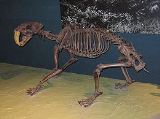
Smilodontini
Encyclopedia
Smilodontini is an extinct tribe of "saber-toothed cat
s", contained within the Machairodontinae
subfamily of the Felidae
endemic to South America
, North America
, Europe
, Asia
, and Africa
living during the Miocene
to Pleistocene
from 10.3 mya—11,000 years ago, existing for approximately .
As the name suggests, the famous genus of Smilodon
is part of this group, but there are also two other distinct genera in Smilodontini. This tribe came into being about the genus Paramachairodus
and only became extinct 10,000 years ago with Smilodon. Various species of Smilodontini have lived in Africa
, Eurasia
, North America
and South America
. All of these are dirk-toothed cats, meaning that they have long narrow upper canines and stocky, well muscled proportions.
Saber-toothed cat
Saber-toothed cat or Sabre-toothed cat refers to the extinct subfamilies of Machairodontinae , Barbourofelidae , and Nimravidae as well as two families related to marsupials that were found worldwide from the Eocene Epoch to the end of the Pleistocene Epoch ,...
s", contained within the Machairodontinae
Machairodontinae
Machairodontinae is an extinct carnivoran mammal subfamily of Felidae endemic to Asia, Africa, North America, South America, and Europe from the Miocene to Pleistocene living from c. 23 Ma until c...
subfamily of the Felidae
Felidae
Felidae is the biological family of the cats; a member of this family is called a felid. Felids are the strictest carnivores of the thirteen terrestrial families in the order Carnivora, although the three families of marine mammals comprising the superfamily pinnipedia are as carnivorous as the...
endemic to South America
South America
South America is a continent situated in the Western Hemisphere, mostly in the Southern Hemisphere, with a relatively small portion in the Northern Hemisphere. The continent is also considered a subcontinent of the Americas. It is bordered on the west by the Pacific Ocean and on the north and east...
, North America
North America
North America is a continent wholly within the Northern Hemisphere and almost wholly within the Western Hemisphere. It is also considered a northern subcontinent of the Americas...
, Europe
Europe
Europe is, by convention, one of the world's seven continents. Comprising the westernmost peninsula of Eurasia, Europe is generally 'divided' from Asia to its east by the watershed divides of the Ural and Caucasus Mountains, the Ural River, the Caspian and Black Seas, and the waterways connecting...
, Asia
Asia
Asia is the world's largest and most populous continent, located primarily in the eastern and northern hemispheres. It covers 8.7% of the Earth's total surface area and with approximately 3.879 billion people, it hosts 60% of the world's current human population...
, and Africa
Africa
Africa is the world's second largest and second most populous continent, after Asia. At about 30.2 million km² including adjacent islands, it covers 6% of the Earth's total surface area and 20.4% of the total land area...
living during the Miocene
Miocene
The Miocene is a geological epoch of the Neogene Period and extends from about . The Miocene was named by Sir Charles Lyell. Its name comes from the Greek words and and means "less recent" because it has 18% fewer modern sea invertebrates than the Pliocene. The Miocene follows the Oligocene...
to Pleistocene
Pleistocene
The Pleistocene is the epoch from 2,588,000 to 11,700 years BP that spans the world's recent period of repeated glaciations. The name pleistocene is derived from the Greek and ....
from 10.3 mya—11,000 years ago, existing for approximately .
As the name suggests, the famous genus of Smilodon
Smilodon
Smilodon , often called a saber-toothed cat or saber-toothed tiger, is an extinct genus of machairodonts. This saber-toothed cat was endemic to North America and South America, living from near the beginning through the very end of the Pleistocene epoch .-Etymology:The nickname "saber-tooth" refers...
is part of this group, but there are also two other distinct genera in Smilodontini. This tribe came into being about the genus Paramachairodus
Paramachairodus
Paramachairodus is an extinct genus of saber-tooth cat of the subfamily Machairodontinae endemic to Europe and Asia, during the late Miocene from 15 to 9 Ma....
and only became extinct 10,000 years ago with Smilodon. Various species of Smilodontini have lived in Africa
Africa
Africa is the world's second largest and second most populous continent, after Asia. At about 30.2 million km² including adjacent islands, it covers 6% of the Earth's total surface area and 20.4% of the total land area...
, Eurasia
Eurasia
Eurasia is a continent or supercontinent comprising the traditional continents of Europe and Asia ; covering about 52,990,000 km2 or about 10.6% of the Earth's surface located primarily in the eastern and northern hemispheres...
, North America
North America
North America is a continent wholly within the Northern Hemisphere and almost wholly within the Western Hemisphere. It is also considered a northern subcontinent of the Americas...
and South America
South America
South America is a continent situated in the Western Hemisphere, mostly in the Southern Hemisphere, with a relatively small portion in the Northern Hemisphere. The continent is also considered a subcontinent of the Americas. It is bordered on the west by the Pacific Ocean and on the north and east...
. All of these are dirk-toothed cats, meaning that they have long narrow upper canines and stocky, well muscled proportions.

